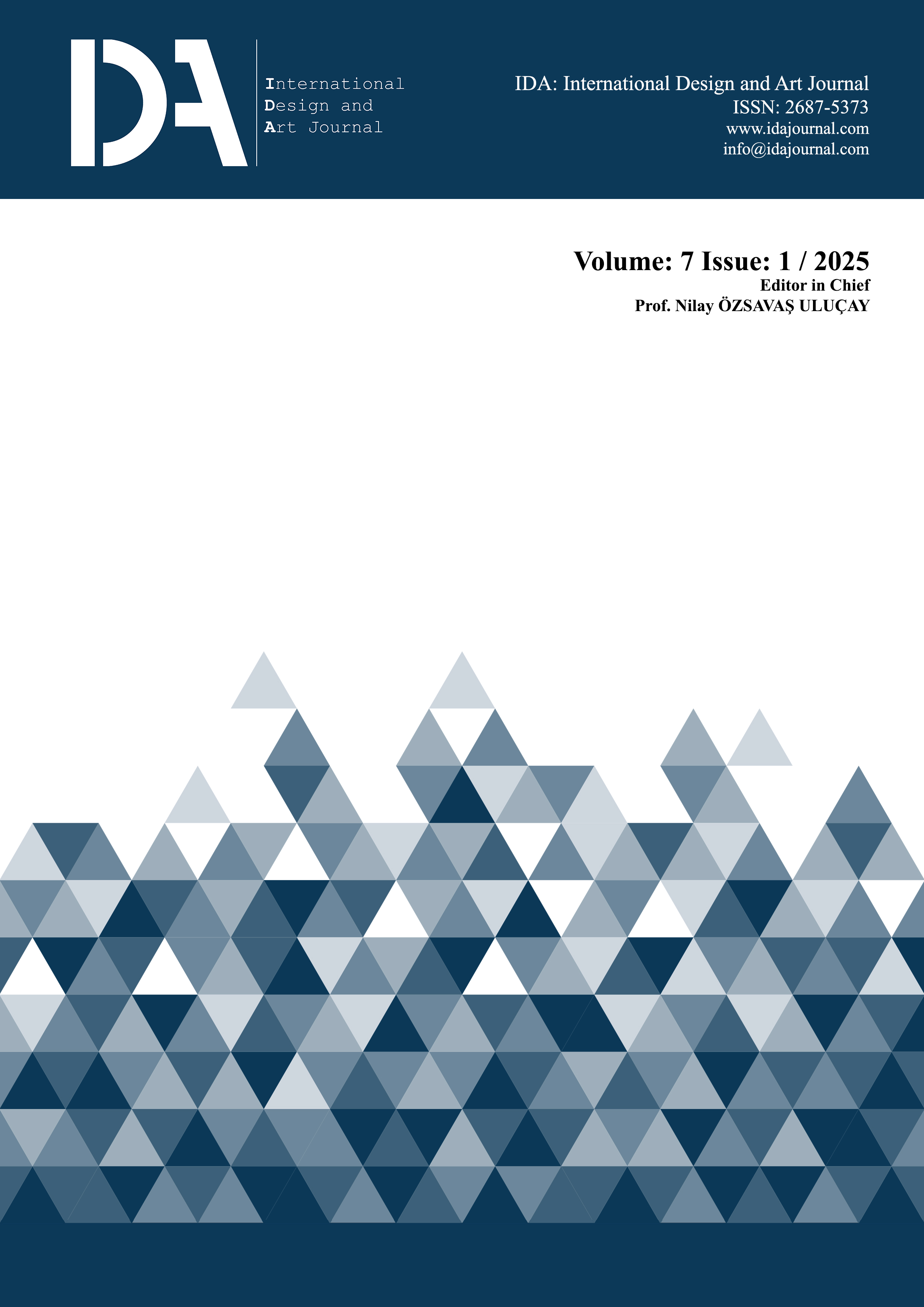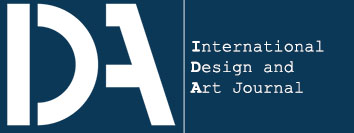A holistic view of design tools in contemporary learning environments: A transmedia storytelling approach
Keywords:
Design education, Design tools, Transmedia storytellingAbstract
In design, knowledge is structured with design tools. Today, many design tools exist, such as sketching, drawing techniques, perspective, diagrams, collages, computer programs, digital reality, and media tools. However, studies have either focused on a single design tool or compared the tools as digital/numerical and traditional/analog. This study sees the multiplicity of tools as a potential for design acquisitions in design education; the contribution of the transmedia storytelling approach, proposed as an alternative design approach, to the use of tools and design acquisition in the presentation phase of the design process is questioned. Thus, the design tools used in the design process by 13 students who accepted to participate in the case study in the Interior Architecture Project I course in the 2023-2024 Spring Semester of the Department of Interior Architecture at Istanbul Technical University were collected as data by the researcher and analyzed. As a result, it was revealed that the proposed approach supports a holistic view of design tools, contributes to the differentiation of design acquisitions and can be used in the presentation phase.
References
Armstrong, T. (2018). Multiple intelligences in the classroom. ASCD.
Asar, H., Çebi, P. (2018). Mimari temsilde kişisel anlatılar: Karışık yapılı temsiller ve dillendirdikleri. Uluslararası Hakemli Tasarım ve Mimarlık Dergisi, 14, 118-143.
Avcı, H. O. (2016). Duyumsamayı ortaya çıkaran bir karşılaşma olarak mimari temsil [Doktora Tezi, İstanbul Teknik Üniversitesi]. Ulusal Tez Merkezi.
Atılgan, D. (2006). Gelişen tasarım araç ve teknolojilerinin mimari tasarım ürünleri üzerindeki etkileri [Doktora Tezi, Dokuz Eylül Üniversitesi]. Ulusal Tez Merkezi.
Aydınlı, S. (2015). Tasarım eğitiminde yapılandırıcı paradigma: “Öğrenmeyi öğrenme”. Tasarım ve Kuram, 11(20), 1-18. https://doi.org/10.23835/tasarimkuram.239579
Bezircioğlu Senvenli, G. (2021). Mimari tasarım sürecinde çizim mekânının keşfi-çizim edimi üzerine bir model önerisi [Doktora Tezi, İstanbul Teknik Üniversitesi]. Ulusal Tez Merkezi.
Blaschke, L. M., Hase, S. (2016). Heutagogy: A holistic framework for creating twenty-first century self-determined learners. Begona Gros, Marcelo Maina, Kinshuk (Eds.). The future of ubiquitous learning: Learning designs for emerging pedagogies (s. 25-40). Spring Verlag.
Ceylan Çapar, M., Ceylan, M. (2022). Durum çalışması ve olgubilim desenlerinin karşılaştırılması. Anadolu Üniversitesi Sosyal Bilimler Dergisi, 22(Özel Sayı 2), 295-312. https://doi.org/10.18037/ausbd.1227359
Clark, A., Chalmers, D. (1998). The extended mind. Analysis, 58(1), 7-19. https://doi.org/10.1093/analys/58.1.7
Çakar, E. (2019). Üretken sistemlerde mimari bağlamın hesaplanabilirliği [Yüksek Lisans tezi, İstanbul Teknik Üniversitesi]. UlusalTez Merkezi.
Dönmez, M., Güler, Ş. (2016). Transmedya hikâyeciliği “Doritos Akademi” örneği incelemesi. Süleyman Demirel Üniversitesi Vizyoner Dergisi, 7(16), 155-175. https://doi.org/10.21076/vizyoner.265477
D’Souza, N. (2007). Design intelligences: A case for multiple intelligences in architectural design. Archnet-International of Architectural Design, 1(2), 15-34.
Dudáček, O. (2018). Contemporary trends in transmedia storytelling. Transmedia television [Doctoral Thesis, University of Girona]. http://hdl.handle.net/10803/670297
Fleming, L. (2013). Expanding learning opportunities with transmedia practices: Inanimate Alice as an exemplar. Journal of Media Literacy Education, 5(2), 370-377. https://doi.org/10.23860/jmle-5-2-3
Freina, L., Ott, M. (2015). A literature review on ımmersive virtual reality in education: State of the art and perspectives. eLearning and Software for Education (eLSE) Conference, Bucharest. http://dx.doi.org/10.12753/2066-026X-15-020
Gambarato, R. R. (2013). Transmedia project design: Theoretical and analytical considerations. Baltic Screen Media Review, 1, 80-100. https://doi.org/10.1515/bsmr-2015-0006
Garcia, M. (2013). Emerging technologies and drawings: The futures of images in architectural design. Architectural Design Magazine, 225, 28-35. https://doi.org/10.1002/ad.1659
Gardner, H. (2005, Mayıs 25). Multiple lenses on the mind. Expo Gestion Conference. Bogota Colombia.
Goldschmidt, G. (1992). Serial sketching: Visual problem solving in designing. Cybernetics and Systems, 23(2), 191-219. https://doi.org/10.1080/01969729208927457
Groat, L., Wang, D. (2013). Architectural research method (2. baskı). Wiley.
Gürçınar, E. (2022). Artırılmış gerçeklik ortamında hazırlanmış eğitsel bir oyun ile üniversite öğrencilerinin zihinde döndürme ve kesit alma yeteneklerinin geliştirilmesi [Doktora Tezi, Mimar Sinan Üniversitesi]. Ulusal Tez Merkezi.
Gürsoy, D. (2023). Eğitimde deneysel yöntemler: Görsel iletişim tasarımının transmedya anlatıları ile buluşması. Ç. Tüker, I. Veryeri, A. Leman, F. Gül (Eds.). “Connected To” çevrimiçi görsel iletişim tasarımı eğitiminde yeni yöntemler new methodologies in online visual communication design education (s.426-458). Mimar Sinan Güzel Sanatlar Üniversitesi Yayınları.
Heidari, P. (2018). Questioning design tools in the early stage of architectural design process: Pen and paper vs. digital sketching [Doktora Tezi, Yıldız Teknik Üniversitesi]. Ulusal Tez Merkezi.
Hollan, J., Hutchins, E., Kirsh, D. (2000). Distributed cognition: Toward a new foundation for human-computer ınteraction research. ACM Transactions on Computer-Human Interaction, 7(2), 174-196. https://doi.org/10.1145/353485.353487
Hutto, D. D., Kirchhoff, M. D., Myin, E. (2014). Extensive enactivism: Why keep it all in? Frontiers in Human Neuroscience, 706(8), 1-11. http://dx.doi.org/10.3389/fnhum.2014.00706
İbrikçi, A. (2019). Mimarlıkta görsel düşünme aracı olarak düşünceli fotoğraf [Yüksek Lisans Tezi, İstanbul Teknik Üniversitesi]. Ulusal Tez Merkezi.
Jenkins, H. (2006). Convergence culture: Where old and new media collide. New York University Press.
Joklova, V., Budreyko, E. (2019). Digital technologies in architectural design, verification and representation. 2019 International Conference on Engineering Technologies and Computer Science, Moscow. http://dx.doi.org/10.1109/EnT.2019.00028
Kararmaz, Ö., Ciravoğlu, A. (2017). Erken dönem mimari tasarım stüdyolarına deneyim tabanlı yaklaşımların bütünleştirilmesi üzerine bir araştırma. Megaron, 12(3), 409-419. https://doi.org/10.5505/megaron.2017.05925
Köknar, S. A. (2009). Tasarım araçları bakışıyla bir tasarlama okuması [Doktora Tezi, İstanbul Teknik Üniversitesi]. Ulusal Tez Merkezi.
Künüçen, H., Samur, S. (2021). Dijital çağın gerçeklikleri: Sanal, artırılmış, karma ve genişletilmiş gerçeklikler üzerine bir değerlendirme. Yeni Medya, 11, 37-62.
López, N. A., Bolinches, R. T. (2020). Transmedia literacy and social networks: Case study of ınstagram as a teaching ınstrument in university classrooms. Revista De Comunicacióny Tecnologías Emergentes, 18(2), 138-160.
Maloney, K. (2014, Nisan 21). Multimedia, crossmedia, transmedia…What’s in a name? Transmedia Journalism. https://transmediajournalism.org/2014/04/21/multimedia-crossmedia-transmedia-whats-in-a-name/
McCullough, M. (2006). 20 years of scripted space. Architectural Design, 76(4), 12-15. https://doi.org/10.1002/ad.288
Orbey, B., Şener, S. M. (2016). Variations in design process: A case study about tool and task as design variants. A/Z ITU Journal of the Faculty of Architecture, 13(3), 167-180. https://doi.org/10.5505/itujfa.2016.80148
Özbaki, Ç. (2016). Model yapma yoluyla tasarım düşünme süreci: Analog ve dijital model karşılaştırması [Doktora Tezi, İstanbul Teknik Üniversitesi]. Ulusal Tez Merkezi.
Özpolat, G. (2022). Dijital uzamda kamusal mekânın üretimi: Twitter verilerine dayalı model önerisi [Yüksek Lisans Tezi, İstanbul Teknik Üniversitesi]. Ulusal Tez Merkezi.
Pak, B. (2009). Desıgn activities and decisions in conventional and computer aided architectural design processes [Doktora Tezi, İstanbul Teknik Üniversitesi]. Ulusal Tez Merkezi.
Pratten, R. (2011). Getting started in transmedia storytelling: A practical guide for beginners. CreateSpace Independent Publishing Platform.
Raybourn, E. (2014). A new paradigm for serious games: Transmedia learning for more effective training and education. Journal of Computational Science, 5(3), 471-481. http://dx.doi.org/10.1016/j.jocs.2013.08.005
Scolari, C. A. (2009). Transmedia storytelling: İmplicit consumers, narrative worlds, and branding in contemporary media production. International Journal of Communication, 3(3), 586– 606.
Serin, A. P. (2016). Etkileşimli teknolojilere sınır kavramı üzerinden bir bakış [Yüksek Lisans Tezi, İstanbul Teknik Üniversitesi]. Ulusal Tez Merkezi.
Şen Bayram, A. K., Güzelci, O. Z., Alaçam, S. (2023). Mimarlıkta sayısal tasarım pedagojisi bağlamında enformel öğrenme. Journal of Computational Design, 4(1), 1-16. https://doi.org/10.53710/jcode.1227228
Tanrıverdi Çetin, Ç. (2020). Mimari çizimin görünmeyen içeriği ve eylemselliği [Doktora Tezi, İstanbul Teknik Üniversitesi]. Ulusal Tez Merkezi.
Tanrıverdi Çetin, Ç., Dülgeroğlu Yüksel, Y. (2020). Tracing the hidden dimension of line in architectural representation. A/Z ITU Journal of the Faculty of Architecture, 17(1), 115-128. http://dx.doi.org/10.5505/itujfa.2020.78800
Yetgin, S. (2011). Sayısal tasarım araçları: Tasarım sürecindeki rolleri bağlamında bir inceleme [Yüksek Lisans Tezi. İstanbul Teknik Üniversitesi]. Ulusal Tez Merkezi.
Yıldırım, B., Kavut, İ. E. (2024). Tasarım imgesinde teknoloji etkisinin eskiz olgusu üzerinden okunması. Yedi: Sanat, Tasarım ve Bilim Dergisi, 31, 189-200. https://doi.org/10.17484/yedi.1296890
Wang, D., Joplin, A. (2009). The design substrate: The phenomenological unity enabling howard gardner’s theory of multiple intelligences. Environmental & Architectural Phenomenology Newsletter, 20(1), 10-15.
Winton, T. E. (2017, Kasım 22). The alternate reality game in architectural education: An adventure in transmedia storytelling, placemaking, history, collaboration, public space, & how playing fosters learning. The alternate reality game. https://www.academia.edu/Documents/in/Alternate_Reality_Games
Downloads
Published
Issue
Section
License
Copyright (c) 2025 IDA: International Design and Art Journal

This work is licensed under a Creative Commons Attribution-NonCommercial-ShareAlike 4.0 International License.
IDA: International Design and Art Journal is an open-access academic journal. All publishing rights of the accepted articles are deemed to assign to IDA: International Design and Art Journal. Articles can not be published and copied anywhere, and can not be used without reference.
IDA: International Design and Art Journal is licensed under a Creative Commons Attribution-NonCommercial-ShareAlike 4.0 International License.



